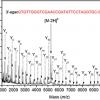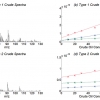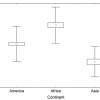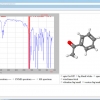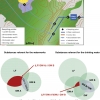Articles
Analysis and sequencing of nucleic acids by matrix-assisted laser desorption/ionisation mass spectrometry
This article gives a most useful overview of the analysis and sequencing of nucleic acids by matrix-assisted laser desorption/ionisation mass spectrometry, which should interest all readers and may well serve as a useful tutorial article.
Investigation of the decomposition of organic solvent-based lithium ion battery electrolytes with liquid chromatography-mass spectrometry
Lithium ion batteries power most of the electrical devices we rely on every day. As well as mobile phones, laptops and tablets, they are finding increasing use in vehicles, with electric cars not uncommon on our streets. This article is from a young scientist who has won help for her research through an instrument company’s support programme. You can find out more, read the article and even apply yourself.
Are they among us? Screening for drugs of abuse and new psychoactive substances in pooled human urine and wastewater samples
The study of metabolites in our sewage systems is not new, but there are particular difficulties with identifying the metabolites from new psychoactive substances, or “legal highs”. The authors describe a wide range of sample collection methodologies and their analysis with mass spectrometry.
Dates and fates of pyrogenic carbon: using spectroscopy to understand a “missing” global carbon sink
Research into climate change takes many directions, but storing carbon or understanding its release from stores is extremely important. Pyrogenic carbon comes from the incomplete burning of biomass, and can be natural, e.g. wild fires, or man-made, e.g. the production of charcoal. The authors describe the uses of a range of spectroscopy techniques to understand the molecular structure of pyrogenic carbon and its role in the global carbon cycle.
Solid mixed matrices and their advantages in matrix-assisted laser desorption/ionisation time-of-flight mass spectrometry
The bio theme moves to mass spectrometry in “Solid mixed matrices and their advantages in matrix-assisted laser desorption/ionisation time-of-flight mass spectrometry” by Marek Šebela. Getting the most from various matrices for use in matrix-assisted laser desorption/ionisation (MALDI) has always been a bit of an art, and the introduction of mixed matrices may increase the number of possible combinations but may improve reproducibility and so simplify analysis in the end. The author describes mixed matrices for a range of samples including proteins, peptides, oligosaccharides, oligonucleotides, lipids, polymers and even intact microbial cells!
Fast and versatile ambient surface analysis by plasma-assisted desorption/ionisation mass spectrometry
This article tells us about another: “Fast and versatile ambient surface analysis by plasma-assisted desorption/ionisation mass spectrometry”. They show that surface analysis can greatly benefit from approaches using surface–plasma interactions and that PADI shows significant promise to become a valuable and versatile tool for this.
A new approach to identifying unknown trace level analytes by tandem mass spectrometry without reference spectroscopic database support: CSI:FingerID
In this column, Tony describes “A new approach to identifying unknown trace level analytes by tandem mass spectrometry without reference spectroscopic database support: CSI:FingerID”. This allows for tandem mass spectrometry data to be used to identify unknown analytes from common molecular structure databases where reference spectroscopic data is unavailable.
Direct Analysis in Real Time mass spectrometry and its application for the analysis of polydimethylsiloxanes
Jürgen Gross has been using ambient mass spectrometry to look at the presence of polydimethylsiloxanes (PDMS) in food prepared in silicone rubber objects and on baking parchment. He shows that PDMS migrates into the food, something perhaps we should think about if in the mood for some baking!
What's up doc: High-precision isotopic analysis of essential metals in biofluids for medical diagnosis
Research is under way as to the possibility of using high-precision isotopic analysis of metals in a biomedical context. The goal is to develop methods for medical diagnosis on the basis of isotopic analysis of mineral elements in biofluids, for diseases that can otherwise only be established at a later stage or via a more invasive method (e.g., a biopsy) and/or for prognosis purposes. Whilst this work is in a very early stage, it is known that various diseases have an influence on the uptake, metabolism and/or excretion of essential mineral elements and thus, can cause a difference in their isotopic composition in biofluids.
Matrix-assisted laser desorption ionisation tandem mass spectrometry imaging of small molecules from latent fingermarks
Robert Bradshaw and Simona Francese tell us about “Matrix–assisted laser desorption ionisation tandem mass spectrometry imaging of small molecules from latent fingermarks“. Especially when looking at small molecules in fingermarks, isobaric species can be a problem and this has the potential to affect the outcome of any court case if not handled appropriately. Tandem mass spectrometry can be used as an alternative to high-resolution MS and ion mobility.
Membrane inlet mass spectrometry for in situ environmental monitoring
“Membrane inlet mass spectrometry for in situ environmental monitoring” by Simon Maher, Fred Jjunju, Iain Young, Boris Brkic and Stephen Taylor looks at a technique that is 50 years old but is now being applied for field analysis. As well as a brief overview of the technique, they show how it can be used to monitor oil-in-water levels before discharge from oil termini.
The use of liquid chromatography tandem mass spectrometry for the investigation of suspected (pesticide) poisoning of vertebrate animals and beneficial insects
This article explains the challenges in pesticide residue analysis of samples associated with suspected poisoning incident investigations, including the wide range of specimens and pesticides that need to be considered.
Ultrafast screen for designer drugs in urine using high-throughput mass spectrometry
In this article we learn of a new definition for “bath salts”, and how modern mass spectrometry instrumentation can provide rapid and quantitation of these “designer” drugs.
Pyrolysis, spectroscopy and extraterrestrial organic matter
This article shows that pyrolysis techniques, in combination with spectroscopy, are helping our understanding of how the organic matter in our solar system came to be. Fascinatingly, they also show how secondary processing of meteorite materials seems to enhance the abilities of atmospheres to host life on planetary surfaces as well as providing the raw materials from which life could originate.
The application of isotope ratio mass spectrometry to the study of the ecophysiology of plant seeds
The use of isotope ratio mass spectrometry is on the rise, with more papers published and more labs with the facilities. The authors describe the main IRMS studies conducted on seeds and isotopes and outline the most important aspects of the use of seeds to study plant eco-geochemistry and plant material traceability.
Proton transfer reaction mass spectrometry
There are many reasons for quantifying VOCs in air, from investigating pollution to diagnosis of diseases in humans. PTR-MS has many advantages for this, not least in speed and ability to provide an online analysis. It is a relatively young technique, but has a range of applications from botany and medicine through to industrial process monitoring, security screening, environmental analysis and food science.
Mass spectrometry investigations of nanoparticles by tandem charge detection mass spectrometry
“Mass spectrometry investigations of nanoparticles by tandem charge detection mass spectrometry” by Tristan Doussineau, Philippe Dugourd and Rodolphe Antoine describes how the limitation of conventional mass spectrometry for weighing macro-ions with masses higher than one megadalton can be overcome with the technique of charge detection mass spectrometry and how they have developed such an instrument for performing MS/MS. This has potential for exploring the “nano world”.
Your committee needs you!
Tony (A.N.) Davies is after your advice in his latest column “Your committee needs you!”. The IUPAC Subcommittee on Electronic Data Standards is keen to learn about areas where you would like to see improvements in moving your data between your analytical instruments and data analysis and reporting packages.
Combining liquid chromatography time-of-flight mass spectrometry for water screening with software tools to identify pesticides and their metabolites
Monitoring drinking water quality poses many challenges and the authors describe their approach that combines instrumental developments with new software.
Mass spectrometry for environmental and wastewater monitoring
Chemical contaminants in water are of concern to all of us. This article reviews the use of mass spectrometry (MS) in environmental and wastewater analysis.

